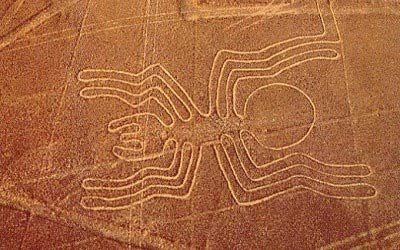
PHOTO: History.com
It was 1927. Peruvian Archaeologist Torbio Meija Xesspe was hiking in the foothills of the Peruvian Desert. When he came to an outlook on the surrounding desert, what he saw took his breath away: a series of huge lines carved into the red sand in the blistering heat, miles long, miles wide. Animals, people, and other unidentified figures stared back up at him. Where had they come from? Who made them, and why?
The site is 200 miles south of Lima, Peru. It’s a plain just in between the Inca and Nazca valleys that’s 1 mile wide and 37 miles wide, spread with over 900 huge geoglyphs. From the ground, they just look like strange tracks in the sand. The sky tells a different story, though.
The site came into the public eye when a surveyor’s aircraft flew over the area where the Nazca Lines are drawn, looking for water. After that, Archaeologists from around the world came to the site to have a look at the phenomenon for themselves. There’s a lot of literature on the subject, and nobody can quite agree why they were made. The puzzling thing about the lines is that the figures that they draw are virtually impossible to see from the ground. In order to actually see the figures, you would have to be up in the air, getting a bird’s eye view. How did the Nazca manage to create geoglyphs this enormous without the technology of flight? What drove them to draw in the sand for 37 miles in the blistering heat?

PHOTO: ancient-origins.net
Nobody agrees on the exact reason for the lines. The people who made them didn’t leave any explanation behind. One swiss writer suggested that they were a massive star chart, but when another scientist ran the 900 glyphs through a computer, matching the lines up with real constellations, no pattern was found. Others have gone so far as to suggest that the site serves as a landing strip for aliens, or for whatever gods the Nazca worshiped. Unfortunately, the desert’s made up of sand and loose stone, so it seems unlikely that it would be able to support any craft that might land there. Another group of scientists and archaeologists suggested that the lines probably have a connection to water. In a region dominated by desert, it seems likely that the Nazca could have constructed the lines in a desperate plea for rain. Another, further-out-there theory has been posed that said that they might possibly be maps to the underground water system in the area. Scientists are running tests on that theory now.
The best theory for the reason for the lines’ construction was posed by English explorer Tony Morrison. Morrison was a specialist in the culture of the people that lived in the Andes mountain, and he had discovered a tradition of wayside shrines constructed for religious and sacrificial purposes, connected by drawn lines in the ground. He said it seemed probably that the Nazca lines exist for the same reason monoliths exist in Europe: to be special enclosures for religious ceremonies. This connection with the tribes in the Andes, combined with the fact that the Nazca were known for having a tradition of human sacrifice, and headless remains have been found on-site makes it seem most likely that the Nazca lines served a ceremonial purpose.
Even if nobody can agree on why the lines were made, there is one theory on the how. We do know that they were constructed by brushing away the top layer of oxidized earth from the lower layer. Most archaeologists and historians agree: the lines that crisscrossed the area that don’t make up the geoglyphs themselves probably were used as a grid, first drawn in small scale at a reasonable size, then enlarged and divided up on the grid so that the workers could create the glyphs using simple surveying techniques.
Interestingly enough, these aren’t the only geoglyphs this massive in the area. The area around the Andes mountains are dotted with similar glyphs. The reason for their creation is still uncertain, and it’s mysteries like this that still captivate archaeologists and historians to this day. It seems that there will always be some parts of the human narrative that remain unsolved, no matter how hard we look. We’re a weird race, and we’ve left some weird things behind. That just makes us and our collective story all the more fascinating in the long run.

